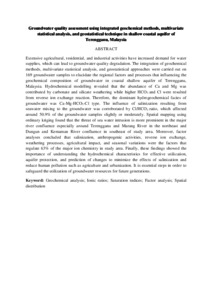Citation
Hamzah, Zahidi and Aris, Ahmad Zaharin and Ramli, Mohammad Firuz and Juahir, Hafizan and Narany, Tahoora Sheikhy
(2017)
Groundwater quality assessment using integrated geochemical methods, multivariate statistical analysis, and geostatistical technique in shallow coastal aquifer of Terengganu, Malaysia.
Arabian Journal of Geosciences, 10 (2).
pp. 1-17.
ISSN 1866-7511; ESSN: 1866-7538
Abstract
Extensive agricultural, residential, and industrial activities have increased demand for water supplies, which can lead to groundwater quality degradation. The integration of geochemical methods, multivariate statistical analysis, and geostatistical approaches were carried out on 169 groundwater samples to elucidate the regional factors and processes that influencing the geochemical composition of groundwater in coastal shallow aquifer of Terengganu, Malaysia. Hydrochemical modelling revealed that the abundance of Ca and Mg was contributed by carbonate and silicate weathering while higher HCO3 and Cl were resulted from reverse ion exchange reaction. Therefore, the dominant hydrogeochemical facies of groundwater was Ca-Mg-HCO3-Cl type. The influence of salinization resulting from seawater mixing to the groundwater was corroborated by Cl/HCO3 ratio, which affected around 50.9% of the groundwater samples slightly or moderately. Spatial mapping using ordinary kriging found that the threat of sea water intrusion is more prominent in the major river confluence especially around Terengganu and Marang River in the northeast and Dungun and Kemaman River confluence in southeast of study area. Moreover, factor analyses concluded that salinization, anthropogenic activities, reverse ion exchange, weathering processes, agricultural impact, and seasonal variations were the factors that regulate 63% of the major ion chemistry in study area. Finally, these findings showed the importance of understanding the hydrochemical characteristics for effective utilization, aquifer protection, and prediction of changes to minimize the effects of salinization and reduce human pollution such as agriculture and urbanization. It is essential steps in order to safeguard the utilization of groundwater resources for future generations.
Download File
![[img]](http://psasir.upm.edu.my/61986/1.hassmallThumbnailVersion/Groundwater%20quality%20assessment%20using%20integrated%20geochemical%20methods.pdf)  Preview |
|
Text
Groundwater quality assessment using integrated geochemical methods.pdf
Download (7kB)
| Preview
|
|
Additional Metadata
Actions (login required)
 |
View Item |

